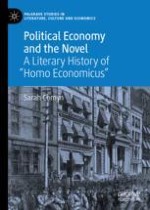2018 | OriginalPaper | Buchkapitel
3. The Speculative World of Sanditon
verfasst von : Sarah Comyn
Erschienen in: Political Economy and the Novel
Aktivieren Sie unsere intelligente Suche, um passende Fachinhalte oder Patente zu finden.
Wählen Sie Textabschnitte aus um mit Künstlicher Intelligenz passenden Patente zu finden. powered by
Markieren Sie Textabschnitte, um KI-gestützt weitere passende Inhalte zu finden. powered by
